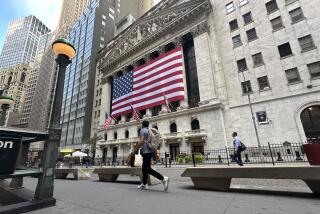Has the bull market in stocks become ‘too big to fail’?
Officially, the Federal Reserve isn’t supposed to worry about keeping stock prices flying high.
But when Fed Chairman Ben S. Bernanke was asked about the market’s outlook last week on Capitol Hill, he sounded like a lot of bullish Wall Street investment strategists.
“I don’t see much evidence of an equity bubble,” he told the Senate Banking Committee in his semiannual testimony on Fed policy. Stocks “don’t appear overvalued given earnings and interest rates.”
More important for the markets, Bernanke pledged to continue the Fed’s policy of pumping colossal sums into the financial system to support the economic recovery.
As stocks flirt with the record highs reached just before the global financial crash of 2008, memories of that catastrophe loom large. Many Americans have abandoned equities since the crash, terrified of living through another one.
Yet the Fed’s efforts to keep the economy growing may not work unless the stock market keeps moving in one direction from here: higher.
“Too big to fail,” the label derisively given to the nation’s biggest banks, now could also be applied to stocks’ 4-year-old bull market.
“The Fed and the other central banks cannot afford to see a massive decline in equity prices,” said Mohamed El-Erian, who oversees $2 trillion as chief executive of money manager Pimco in Newport Beach.
Steven Ricchiuto, chief economist at Mizuho Securities USA in New York, puts it another way: If the stock market were to fall drastically, “You would have every economist screaming ‘Depression!’”
That might not be what would actually unfold, Ricchiuto said. But the effects on the fragile global economy would be painful nonetheless, he said.
Corporate executives, fearing that a sustained market slide was signaling a new economic slump, could quickly react to tumbling stocks by launching a round of severe job cuts to protect their rich profit margins, as they did in late 2008 and early 2009. That could torpedo the fledgling jobs recovery and make an economic downturn self-fulfilling.
What’s more, a market plunge could trigger spending cuts by well-off consumers who control most of the nation’s wealth, and who have therefore benefited the most from stocks’ rebound since 2008. The top 20% of U.S. households by income account for 38% of consumer spending.
A strong footing
For now, the bull market still appears on strong footing: The Dow Jones industrial average ended Friday at 14,089.66, up 115% from the crash low reached on March 9, 2009 and just 0.5% below its all-time high set in October 2007.
Shares also have rallied sharply in Europe and Japan in recent months, and policymakers in those economies are eager to see the markets build on those gains as a sign of confidence.
European Central Bank Chief Mario Draghi is credited with sparking the turnaround in stocks in Europe and the U.S. last summer after he vowed to do “whatever it takes” to ensure that the continent’s debt struggles wouldn’t break up the Eurozone. An index of 600 blue-chip European stocks has jumped 23% since June.
Draghi’s resolve is being tested again after Italy’s recent election, as voters rejected the government spending cuts that were aimed at calming fears about the country’s debt load. But like Bernanke, Draghi last week offered comforting words, saying the ECB was far from ending its program of providing money to the financial system at near-zero interest rates.
In Japan, the Nikkei-225 share index has rocketed 34% since mid-November to 11,606, the highest level since 2008, as the new government led by Prime Minister Shinzo Abe has pledged fresh efforts to stoke the flagging economy. That also has driven down the value of the yen, a boost for Japan’s all-important export giants.
Japan’s economics minister, Akira Amari, last month went so far as to set a target of 13,000 for the Nikkei by April 1. The new government wants to take more steps “to help stock prices rise,” he said.
Neither U.S. nor European policymakers would be bold enough to try talking up the market that explicitly. But they all have the same goal in trying to armor-plate this bull market: revive the so-called virtuous circle, wherein higher stock prices feed economic confidence, which in turn feeds more market optimism and encourages companies and investors to take more risk. That, in theory at least, should boost economic growth.
‘Lost decade’
With major U.S. stock indexes at or near all-time highs, market bulls face the challenge of persuading sidelined investors that it’s not too late to get in. A central tenet of the bulls is that stocks have ended the painful “lost decade” of the 2000s, when the market made no net progress. The optimistic view is that Wall Street since 2009 has been in a new “secular” bull market, meaning an advance that will be long-lasting, such as the 1990s’ rally.
“I think the whole game plan of the Fed is to give people that assumption” about a new secular bull run, said Bert Dohmen, a veteran market analyst and head of Dohmen Capital Research in Los Angeles.
That doesn’t mean the Fed would sweat a normal “correction” in stocks that might temporarily shave 10% or so off prices. But another bear market any time soon — a drop of 20% or more — could be too big a shock for the economy to handle, some analysts say.
Yet the Fed’s program of printing trillions of dollars since 2008 to buy bonds as a way to suppress interest rates also has revived criticism that policymakers have become blatant market manipulators — a de facto “plunge protection team,” a term coined after the 1987 stock market crash.
Bernanke has heard those allegations many times, but still bristled during his testimony last week when Sen. Bob Corker (R-Tenn.) accused the Fed of creating a “sort of faux wealth effect” by helping to drive interest rates down and stocks up.
Bernanke denied that, saying the central bank was trying to fuel “a genuine increase in wealth” by stimulating the economy and boosting entrepreneurial activity.
That’s a hard sell for some individual investors, including 78-year-old Mike Celeste, who says he gave up on long-term stock investing more than a decade ago and has since just focused on short-term trading. The San Dimas resident worries about the effect on markets when interest rates finally rise.
“How long can they continue to have a false interest rate?” he said of the Fed’s benchmark short-term rate, now 0.25%.
Global economy
Some economists say the greater threat to stocks isn’t that rates will rise soon, but that the global economy will continue to struggle, weighed down by the burden of debt taken on in the boom era of 1983 to 2007. That raises the risk that corporate sales and earnings growth will stall, which could pull the rug out from under equity prices.
The Eurozone and Japan both are back in recession, and the British economy also contracted in the fourth quarter. The U.S. economy barely grew last quarter, advancing at a 0.1% annualized rate, and now faces automatic federal spending cuts under the budget sequestration mandate.
Growth also has slowed in much of the developing world, including Brazil, Poland and South Korea.
“Where is the growth going to come from?” to drive earnings, Ricchiuto of Mizuho Securities asked skeptically.
But recent reports have pointed to surprising strength in the U.S. economy this year. New home sales jumped to an annual rate of 437,000 units in January, well above estimates and the highest since July 2008. And an index of U.S. manufacturing activity rose in February to the highest level since June 2011.
Even if the economy posts anemic growth in the near term, Wall Street bulls are betting that a combination of three major market shifts — and some luck — could keep stocks aloft. The shifts:
• Stock price-to-earnings ratios rise. Simply put, this means investors would be willing to pay a higher share price for the same amount of a company’s underlying earnings.
Based on estimates of 2012 earnings, the average price-to-earnings (P/E) ratio of the Standard & Poor’s 500 blue-chip stocks is in the range of 14.6 to 15.6 (depending on how you measure so-called operating earnings).
Stock P/Es typically rise when interest rates are low and investors grow more optimistic about the future. The S&P; 500 P/E reached 30 at the market peak in 2000, when the tech mania was at its zenith. The P/E was about 17.5 at the peak in 2007.
Ethan Harris, co-head of global economics research at Bank of America Merrill Lynch in New York, believes that higher P/Es are warranted given the likelihood of the Fed holding interest rates down for a long time to come.
“The main case for the equity market is valuation,” Harris said. And if investors believe that global growth will pick up in 2014, as Harris does, it could be easier for them to justify getting into the stock market now or boosting their bets.
• Fatter dividend payments lure investors. The corporate earnings boom since 2009 has powered a surge in dividend increases by companies large and small. Total dividends paid by the S&P; 500 companies reached a record $281 billion last year.
With many investors seeking decent income amid near-zero interest rates, cash-rich companies are expected to respond by sharing more of their profit with stockholders. Howard Silverblatt, senior index analyst at S&P; in New York, said S&P; 500 dividend payments in January were up 25% from a year earlier.
Investors could be facing a new era in which stock market returns come more from dividends than from capital appreciation, said David Nicholas, chief investment officer of the Nicholas mutual funds in Milwaukee. “You could see a 5%, 6% or 7% average [annual] total return on stocks, with 70% of that coming from dividends,” he said.
• Money shifts from bonds to stocks. Millions of investors have sought refuge in bonds over the last five years — a smart move as central banks have continued to push down market interest rates, rewarding those who locked in higher yields.
What’s next?
But with yields now so low, investors like Patricia Jeffares in Camarillo worry about what’s next.
If market interest rates were to rise, Jeffares, 66, knows that her bonds would lose value. She has about 60% of her assets in bonds and 40% in stocks, but is thinking about shifting that mix somewhat. “Should I move out of bonds and into stocks?” she wondered.
The longer the stock market recovery has gone on, Jeffares said she has worried less about another crash.
“I don’t think there’s going to be a pullback like 2008,” she said.
That’s the view the Fed and other central banks want to see blossom among the ranks of investors, because confidence tends to feed on itself.
A crucial next step, Pimco’s El-Erian said, would be for rising confidence to boost spending by wealthy consumers worldwide, the middle-class of the developing world, and financially
robust companies. “There are a lot of healthy balance sheets around the world,” he said.
With the stakes so high, El-Erian and Harris see no chance that the Fed and other major central banks will pull back from providing whatever financial support they can to the markets and the economy, despite the risk of eventually creating new asset bubbles or fueling inflation.
The end of the Fed’s money-printing campaign “is nowhere in sight,” Harris said. “It keeps bond yields low and the stock market up.”
More to Read
Inside the business of entertainment
The Wide Shot brings you news, analysis and insights on everything from streaming wars to production — and what it all means for the future.
You may occasionally receive promotional content from the Los Angeles Times.










